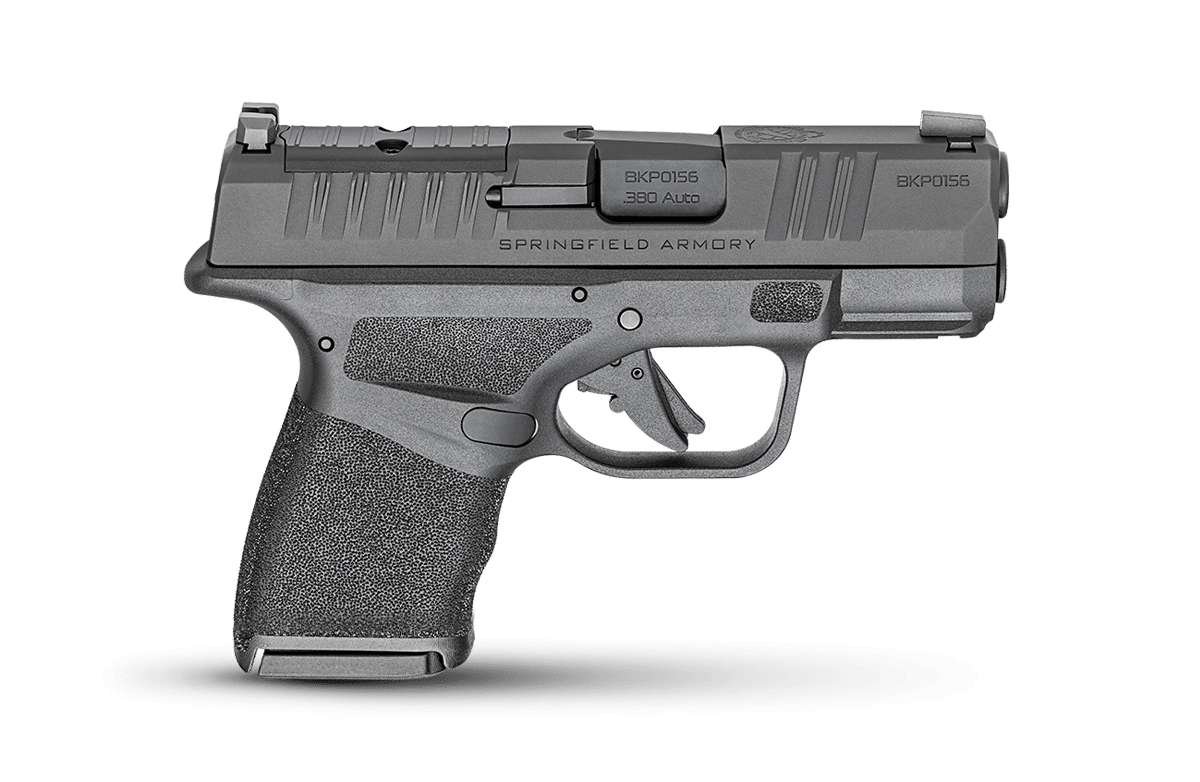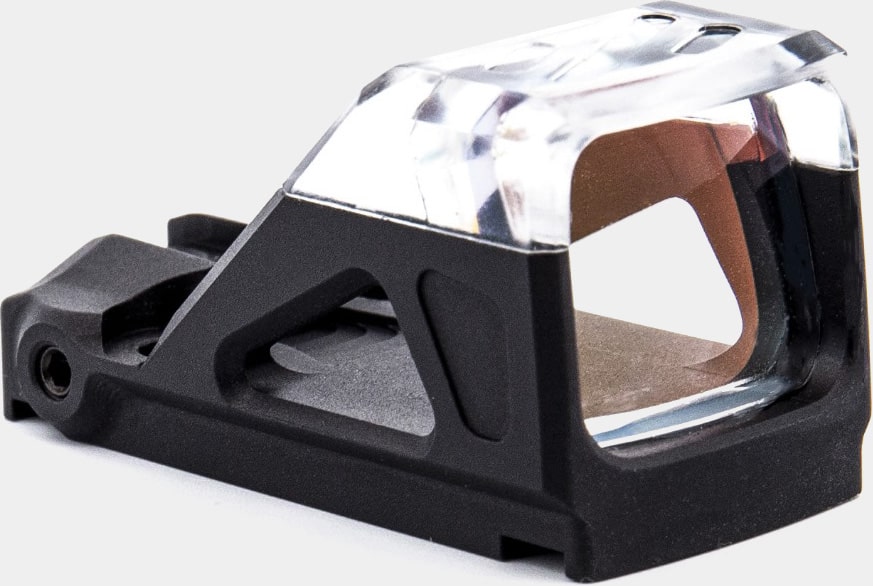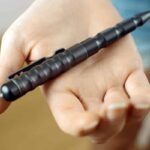In today’s Springfield Hellcat .380 ACP review, Jeremy Tremp takes a look at the new concealed carry pistol. The micro-compact handgun offers considerable firepower in a softer-recoiling platform. Could this be the best CCW pistol available? The handgun was loaned to the author by Springfield Armory for this review.
Choosing to carry every day is a commitment. Gear has to fit your life, not the other way around. That is why a lot of folks keep circling back to smaller pistols that are simple to conceal and easy to control. Enter the new Springfield Armory Hellcat OSP in .380 ACP. Here’s the short version: Same Hellcat DNA, but in a softer-shooting caliber.
I have carried a lot of micro pistols over the years. In fact, my very first CCW was actually a pistol chambered for the .380 ACP as the round has much to offer. While you give up a little on raw horsepower compared to 9mm, you have a cartridge that still offers impressive power as well as controllability — that latter point being particularly true if used in the right platform.
The .380 ACP round itself has been around for a very long time. Effectively a short 9mm (think .38 Special and .357 Magnum), the .380 offers you a chambering that is easy to carry yet doesn’t have to punish you.
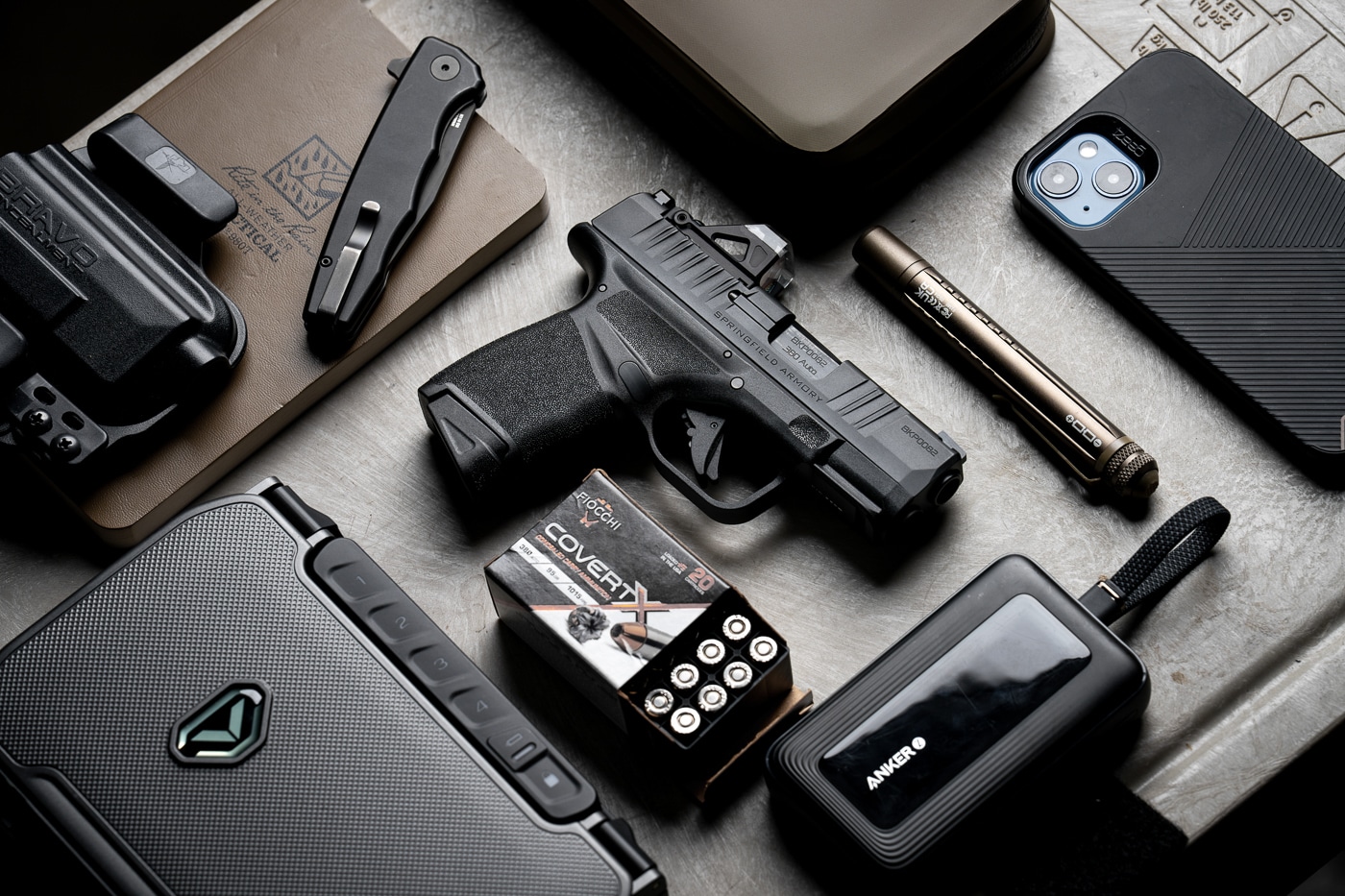
Because the recoil is lighter, it’s a lot easier to stay on your sights and get that follow-up shot right where you want it. You’re not wrestling the gun like you sometimes do with a micro 9mm. Inside the distances where defensive pistols are employed, that extra control is a real advantage.
[Not already familiar with the Hellcat? Read Mike Humphries’ Hellcat 9mm review.]
Hellcat .380 Details
The Hellcat .380 sticks to the same carry-first formula that made the Hellcat family so famous. It features a 3” barrel, a double-column flush-fit 11-rounder and an extended 13-rounder magazine, and a slim slide and frame that tucks under light clothing. The result is a pistol that doesn’t print when you’re moving around. The dimensions sit right at the 1”-width mark, which is the sweet spot for true micro pistols. Weight is low and manageable at around 16 oz.
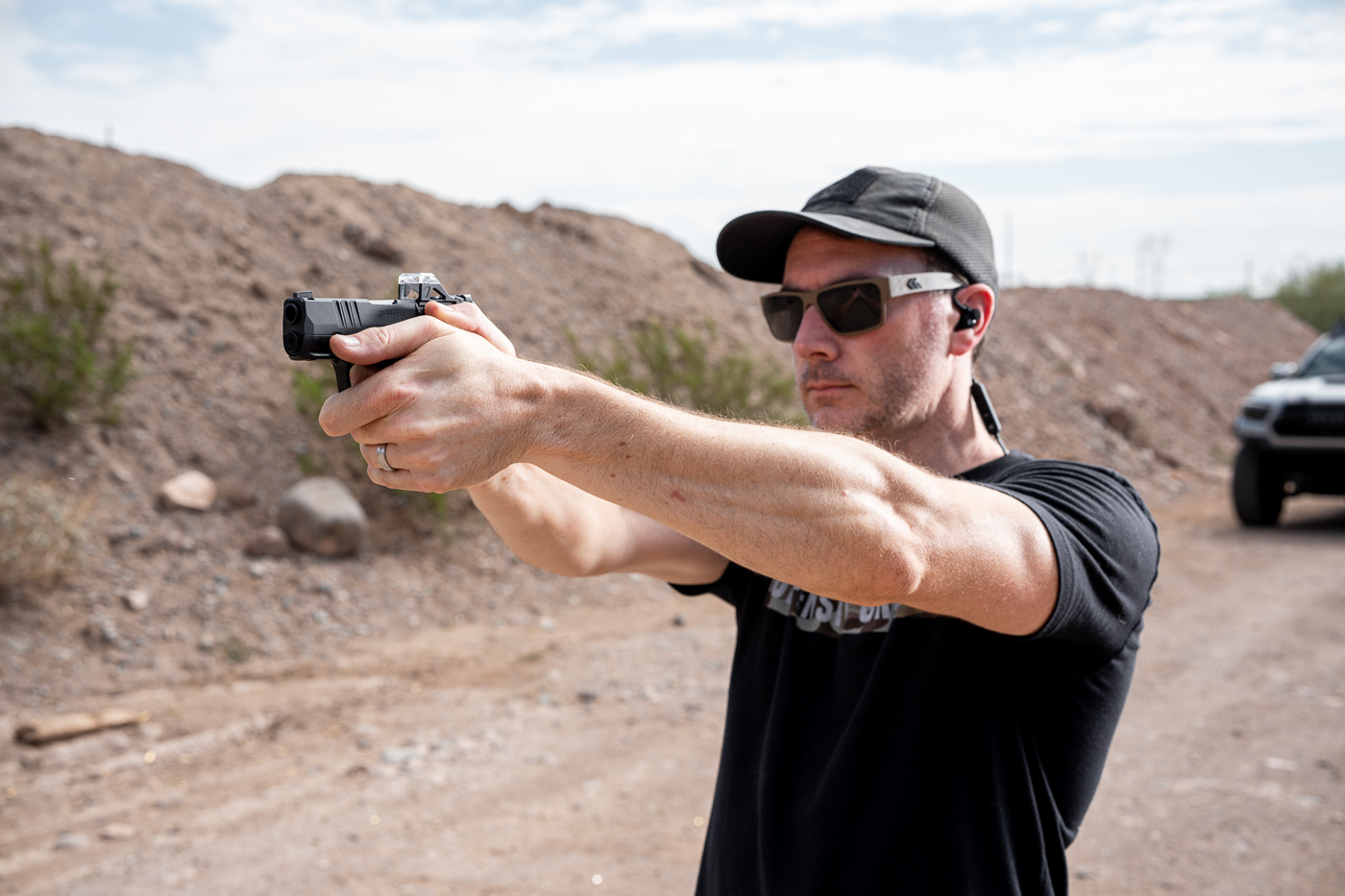
Springfield brought over the key features from the 9mm Hellcat we’ve come to expect. The frame has the same Adaptive Grip Texture, which locks into your hand when you grip hard but stays comfortable against the skin when it’s riding in the holster. The slide is cut with serrations at the front, top, and rear, so you can rack the pistol however you like and still get traction, even with sweaty hands. The U-Dot sight system is standard, pairing a large and bright tritium/luminescent front dot with a simple rear “U-notch” iron sight that makes for quick target acquisition.
Out of the box, the Hellcat OSP .380 ships with two magazines. One is an 11-round flush-fit unit that is shorter and wears a pinky extension, which keeps the footprint small but still gives you a little more to hold onto. The other 13-round mag is extended for a full-hand grip as well as a bump in capacity. I like this flexibility. Most of the time I’ll carry the short mag in the pistol for concealment, and drop the longer mag in a pocket or sling bag as a spare.
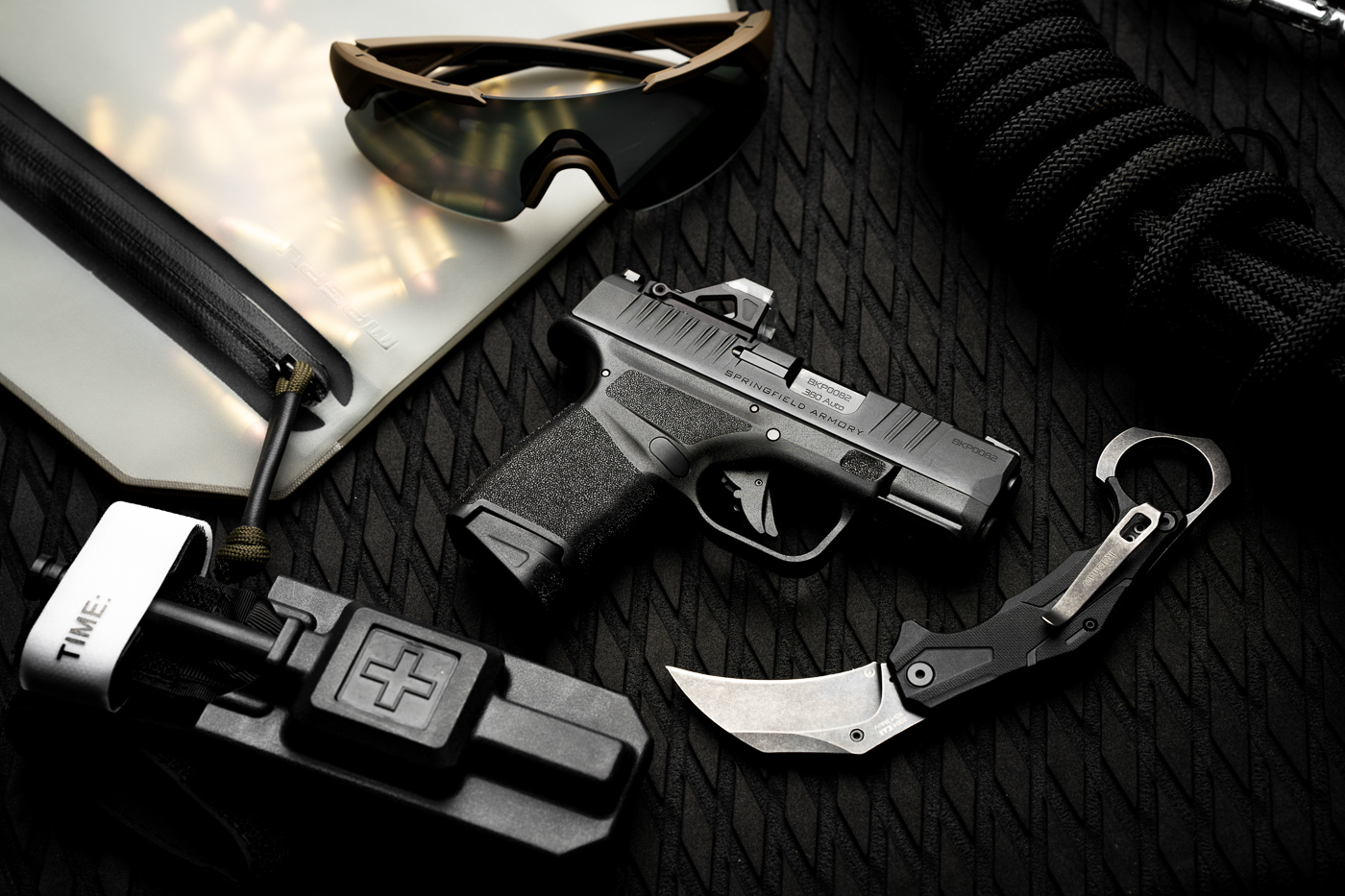
The frame also includes a section of accessory rail, and Springfield kept it non-proprietary. That means you can fit common micro lights or lasers if you want. It’s a nice option, though keep in mind you’ll need a holster cut for it. Personally, I’ll probably keep this one slick and light for maximum concealability.
This is the kind of pistol that simply disappears when you carry it. At the 3:30 position in a slim inside-the-waistband (IWB) holster, the short grip doesn’t push out against clothing, and the slide length is short enough to stay comfortable even when sitting or driving. For appendix carry, a small wedge can help angle the muzzle and keep the pistol tight to the body. Because it’s so light, belt sag isn’t an issue. This is one of those guns you can put on in the morning and “forget about it” until you take it off at night.
About the .380 ACP
In the firearms world, some cartridges have similar names. This can lead to confusion, and in the worst cases, even be dangerous. If you try to shoot the wrong cartridge in a firearm, you could have a catastrophic accident. So, let’s talk about the .380 ACP cartridge and the Hellcat pistol designed to shoot it.
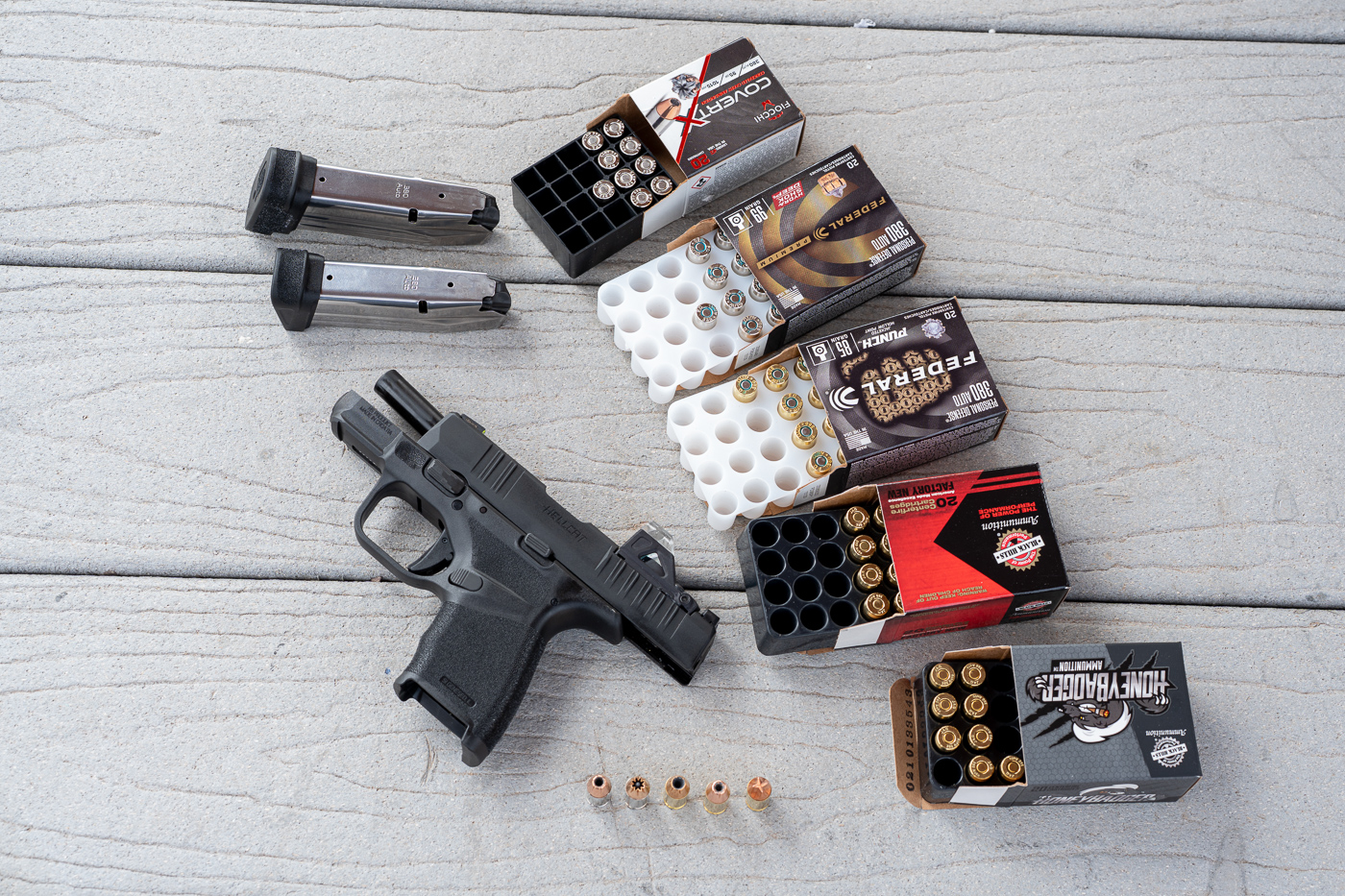
The Hellcat .380 is chambered for the .380 ACP cartridge. Any SAAMI-spec, factory cartridge loaded for the .380 ACP will fire safely in the pistol. Some companies also use the terms .380 Auto and .380 Automatic for the cartridge.
You may also see the terms 9x17mm and 9mm Kurz. Although these use “9mm” in the name, they are the same as the .380 ACP cartridge. They are safe to fire in this pistol. Other uncommon terms are also used for the .380 ACP — check with the dealer where you are buying them and only use them if you are 100% sure they are in SAAMI specifications.
Caution: Do not use other 9mm rounds such as 9x19mm, 9mm Parabellum or 9mm Luger. These are different cartridges loaded to much higher chamber pressures. They can damage your gun and cause injury to you should you try to shoot them in the Hellcat .380.
Hellcat OSP .380 Specifications
| Chambering | .380 ACP |
| Barrel Length | 3″ |
| Weight | 16.1 oz. |
| Overall Length | 6″ |
| Sights | Tritium U-Dot |
| Grips | Integral, polymer |
| Action | Striker-fired |
| Finish | Melonite |
| Capacity | 11+1/13+1 (one each included) |
| MSRP | $653 |
A Clear View
This Hellcat is offered in an OSP (Optical Sight Pistol) configuration, which means the slide is milled for direct-mounting optics with the Shield RMS/SMS footprint. The direct-mount system means that the sights can co-witness through most if not all of these optics.
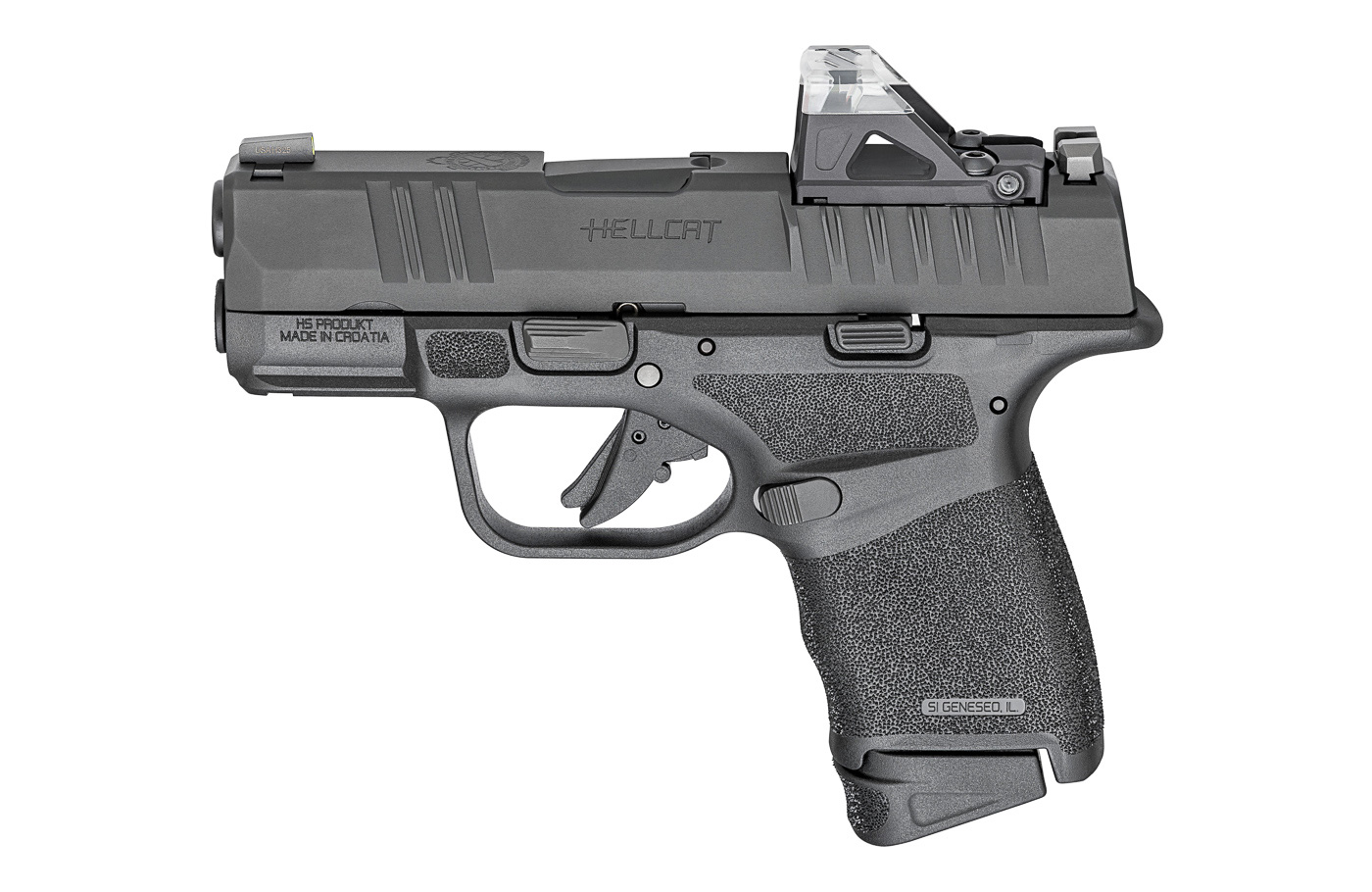
I had the opportunity to try out the new pistol with a new optic from Shield Sights. That optic is the OMSsc, which stands for “Open Mini Sight Sub Compact.” Described as the world’s first “panoramic roof” optic, the aluminum-bodied optic employs a translucent acrylic roof and weighs in at just .51 of an ounce. Combine that with its extremely compact dimensions (1.60”x0.74”x0.84”), and you have an optic that offers both small dimensions and a large, unobstructed view.
This tiny optic gives you a fast, clear aiming point. The translucent roof on that optic lets in extra light and keeps the window wide open for such a small footprint. I still appreciate irons on a carry gun, but on pistols this size a red dot can be a real advantage for quick shots and for shooters whose eyes aren’t what they used to be.
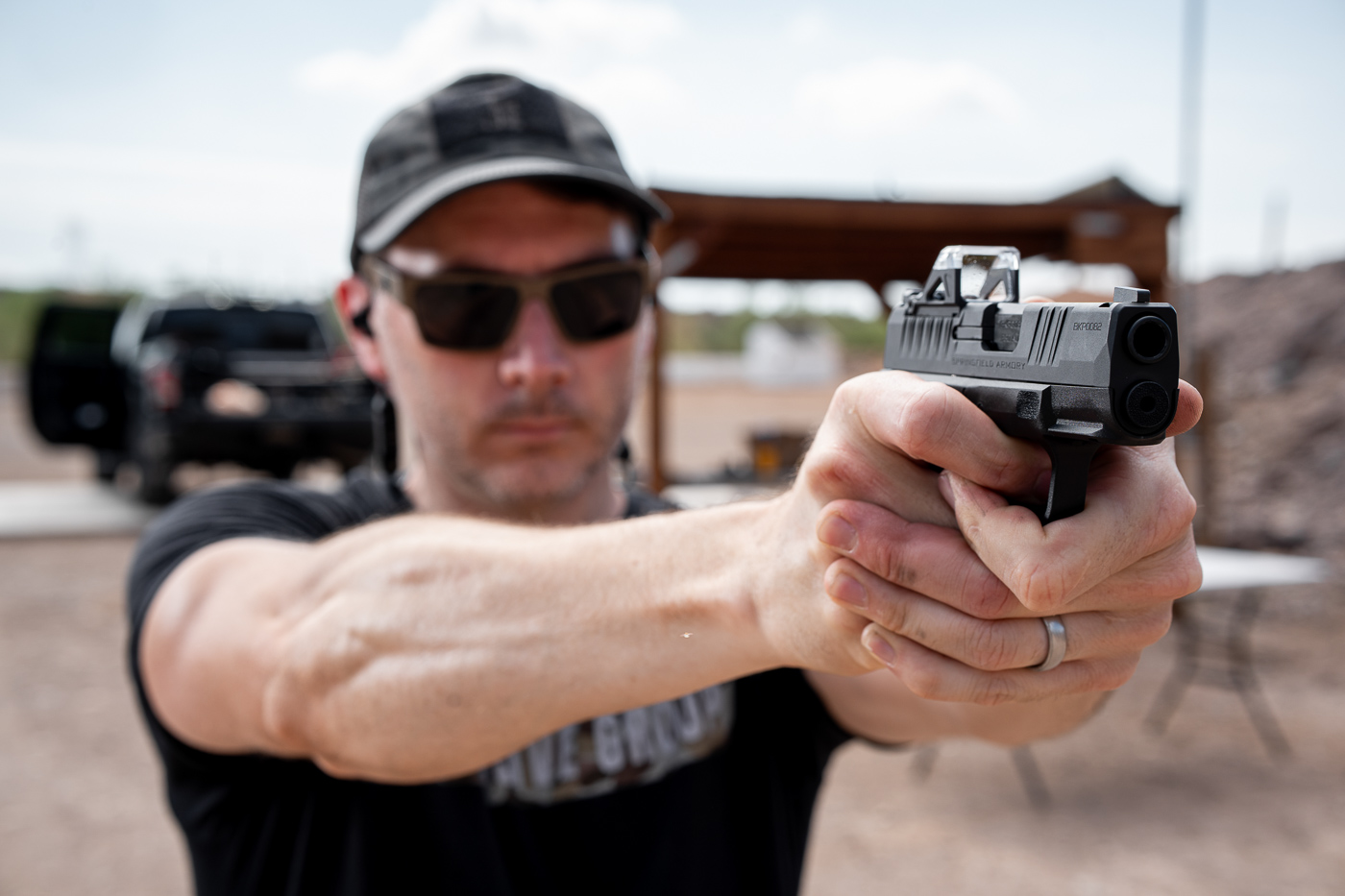
However, if you want to keep it simple, the .380’s included slide cover plate fills the milled optic-mounting slot to give you a handy, iron-sighted EDC. However, for me, having an optic that can co-witness with the irons is the best of both worlds.
Range Time with the Hellcat .380 Pistol
For me, the main reason to choose the .380 ACP version of the Hellcat is the way it shoots. Micro 9mms can be snappy and, while they’re impressive for their size, they can wear you out in a long training session. The .380 ACP cartridge softens that up noticeably. With the Hellcat chambered in .380 ACP, the sights just seem to settle back quicker. Follow-up shots don’t take as much effort, and even shooting one-handed feels a lot more manageable.
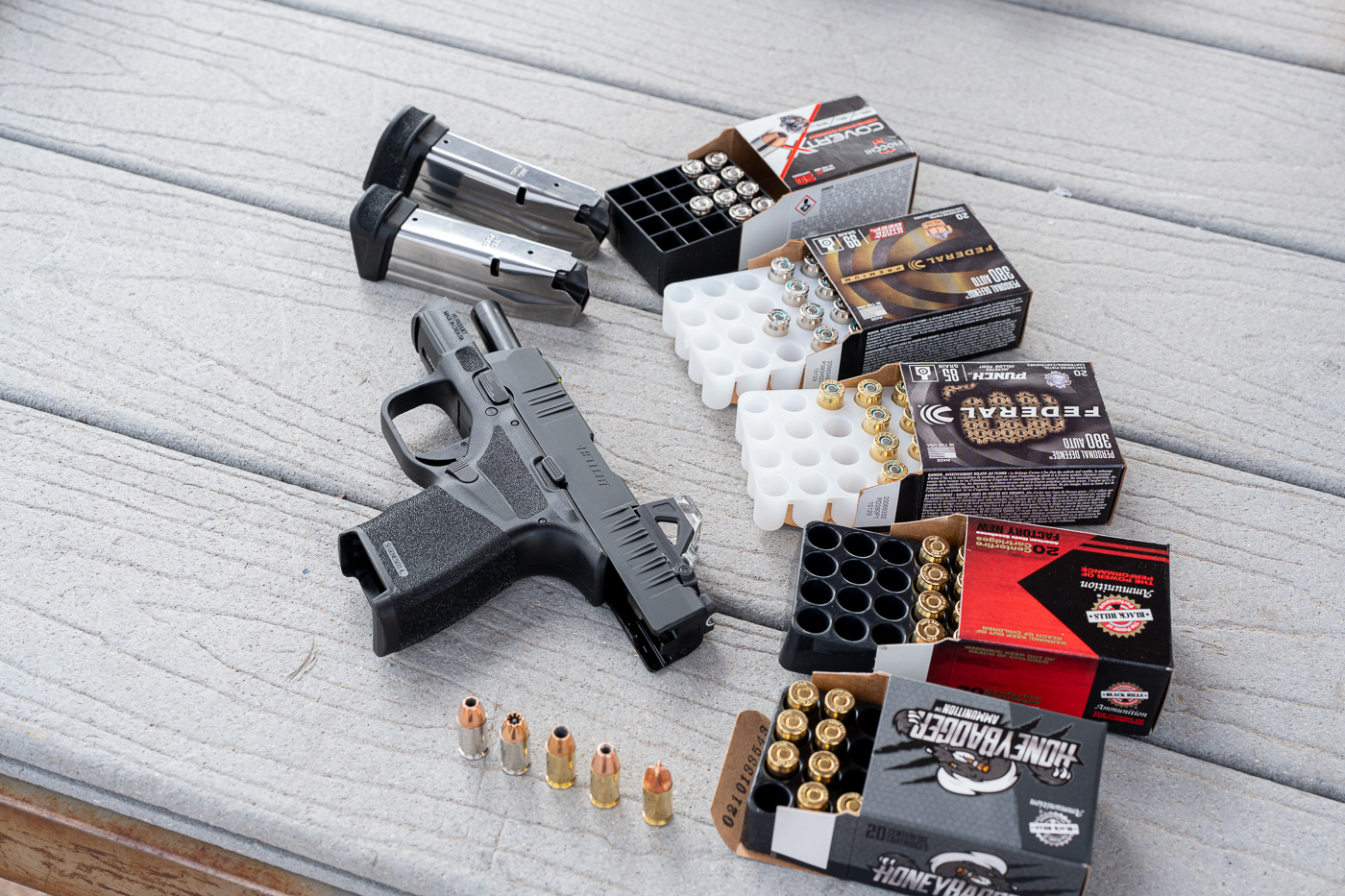
Is .380 ACP as powerful as 9mm? No, and it’s not supposed to be. What it offers instead is a balance: a caliber that is manageable, shootable and confidence-inspiring. That’s a combination that makes sense for a lot of everyday carriers.
A pistol chambered in .380 Auto is all about balancing control with enough ballistic performance for defensive use. That’s why ammo choice is critical. For my testing, I ran the Hellcat .380 with a mix of common defensive loads to get a feel for how it performs across the board.
Hellcat .380 Reliability
On the range I was able to test five flavors of ammunition: Black Hills 60-gr. HoneyBadger, Black Hills 90-gr. Jacketed Hollow Point (JHP), Federal Punch 85-gr. JHP, Federal 99-gr. Hydra-Shok, and Fiocchi CovertX 95-gr. JHP. During my multiple range sessions, all the defensive ammo ran through the gun with perfect reliability, smooth feeding and steady cycling.
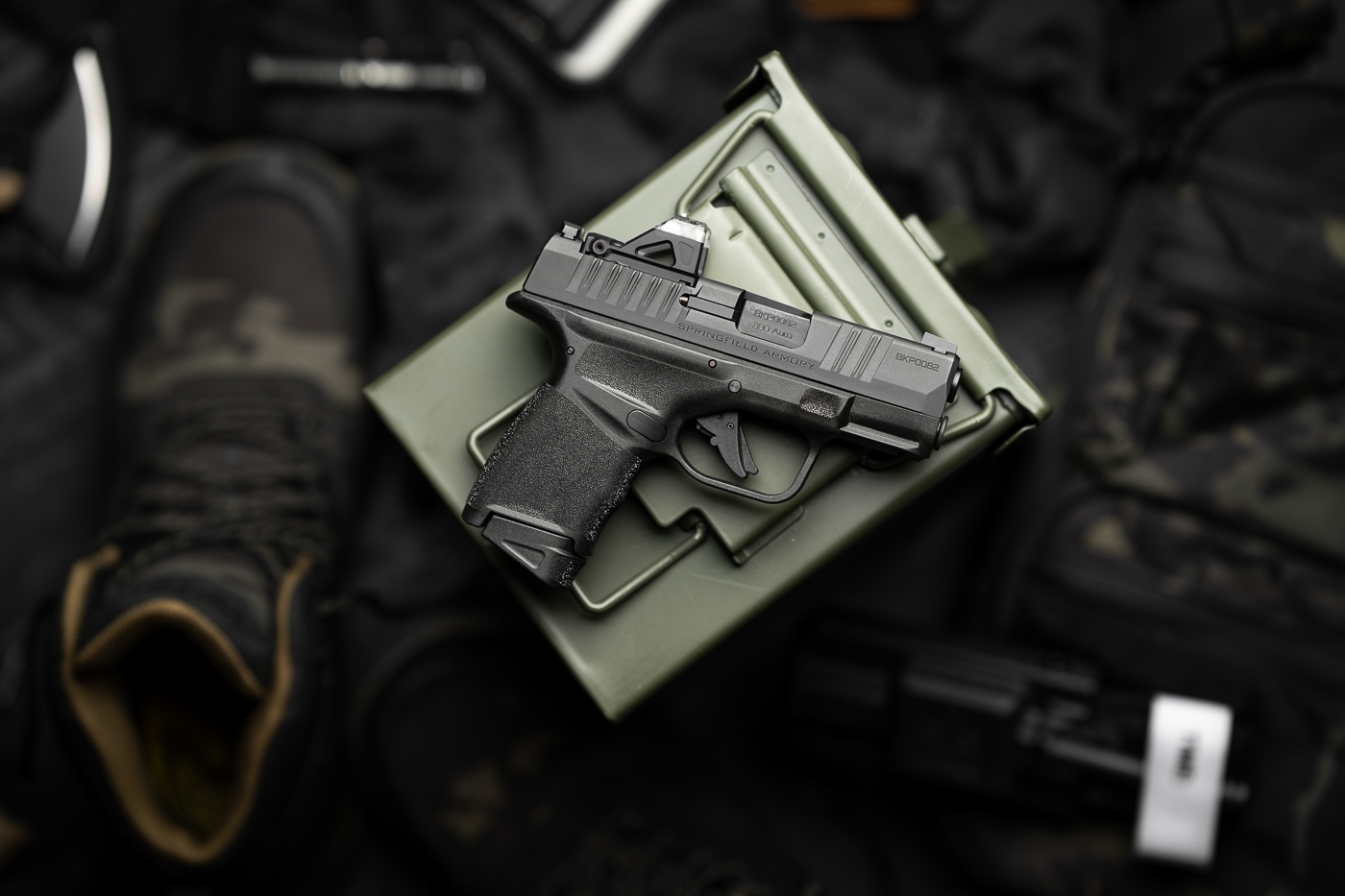
It was an interesting experience shooting the Hellcat in .380, as I have been used to shooting 9mm Hellcat’s for the past five years. I know exactly what to expect when I pull that trigger. Shooting the .380 was quite enjoyable and a nice change of pace. The pistol is incredibly tame and easy to shoot, especially with some of the heavier-grain ammunition such as the 95- and 99-gr. loads. With these, muzzle rise was nearly non-existent.
On my second range day with the pistol, I did some basic accuracy and velocity testing from 15 yards. Accuracy results were quite good, with it averaging just over 1” at that distance. Average velocity results in feet per second (fps) were as follows:
I ended up running out of time and did not get to accuracy and velocity test the Black Hills 90-gr. JHP load.
I found that the slide on this Hellcat is surprisingly easy to rack for a micro pistol, which is a big plus for newer shooters. The magazine release is sized right; it’s easy to hit on reloads, but not oversized to the point of causing snags. The slide stop sits where it needs to be without getting stopped up by your support hand. Springfield also carried over the stand-off surface at the front of the guide rod, which is designed to keep the pistol in battery if it’s pressed against a surface. It’s a detail you hope to never need, but I’m glad it’s there.
Conclusion
The way I see it, the Hellcat .380 is a strong option for a few different groups of shooters. For people who are newer to carrying, the softer recoil makes it easier to train with, which means you’ll shoot more and build confidence faster. For anyone who struggles with the snap of micro 9mms, whether that’s due to grip strength or just personal preference, this .380 is a welcome alternative. Or, you might be an experienced shooter who just wants a Hellcat that is easy to carry and even easier to shoot well.
The new Hellcat OSP in .380 ACP fills a real need in the concealed carry world. The Hellcat OSP .380 is small, easy to carry and very comfortable to shoot. That might sound basic, but those qualities are what decide whether a pistol stays in the safe or actually goes on your belt every day. Springfield kept all the things that made the Hellcat popular in the first place, and paired it with a softer-shooting chambering.
This is a pistol built for real-world carry. It’s not about chasing maximum power. It’s about giving people a pistol they can shoot well, carry without compromise and trust when it matters. For many of us, that’s exactly the combination for which we’re looking.
Editor’s Note: Please be sure to check out The Armory Life Forum, where you can comment about our daily articles, as well as just talk guns and gear. Click the “Go To Forum Thread” link below to jump in and discuss this article and much more!
Join the Discussion
Featured in this video
Read the full article here



